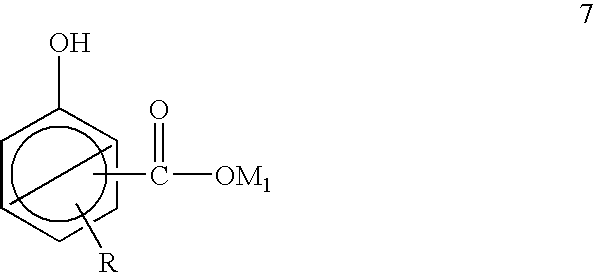Overbased alkali metal alkylhydroxybenzoates having low crude sediment
a technology of alkali metal alkyl hydroxybenzoates, which is applied in the direction of lubricant compositions, chemistry apparatus and processes, organic chemistry, etc., can solve the problems of reducing product yield and creating added disposal costs
- Summary
- Abstract
- Description
- Claims
- Application Information
AI Technical Summary
Benefits of technology
Problems solved by technology
Method used
Image
Examples
example 1
A) Formation of the Alkali Metal Base Alkylphenate:
[0138] Alkylphenols (1000 g) prepared from mixtures of linear normal alpha olefins (C20-C28 alpha olefins from Chevron Phillips Chemical Company), xylene (500 g) was placed in a reactor and heated to 60° C. over a period of 15 minutes then 290 g of an aqueous solution at 45% KOH (2.325 mole) and 0.2 g of a defoamer called Rhodorsil 47V300 (available from Rhodia) were added. The reactor was then heated further to 145° C. over a period of 2 hours while gradually decreasing the pressure from atmospheric pressure (1013 mbar absolute—1×105 Pa) to 800 mbar absolute (8×104 Pa). Under these conditions, reflux begins and was maintained for 3 hours. During this period, approximately 179 ml of water was removed.
B) Carboxylation:
[0139] The reactor containing the alkali metal alkylphenate from step A) was allowed to cool to 140° C. The reactor was then pressurized with CO2 at 4 bar (4×105 Pa) (absolute pressure) and maintained under these c...
example 2
[0146] Example 2 was prepared as described in Example 1 but two slurries are introduced at overbasing step (step C).
C) Overbasing
[0147] 1418 g of the alkali metal alkylhydroxybenzoate from step B) was loaded under agitation into a reactor over 10 minutes period.
[0148] Then a slurry of methanol (239 g), lime (239 g) and xylene (407 g) was introduced, once the slurry was added, a mixture of formic acid (7 g):acetic acid (7 g) was added and allowed to react with the contents in the reactor.
[0149] The reactor was heated up to 30° C. over a period of 15 minutes. Once the temperature of the reactor had reached 30° C., CO2 (111 g) was introduced into the reactor over a period of 140 minutes then an additional slurry of methanol (52 g), lime (52 g) and xylene (126 g) was introduced and an extra quantity of CO2 (41 g) was introduced into the reactor over a period of 47 minutes.
[0150] The reaction yielded a potassium alkylhydroxybenzoate overbased with calcium carbonate. The percentage ...
example 3
[0153] Example 3 was prepared as described in Example 2 but a higher TBN (TBN=400) is targeted so a little bit more lime and CO2 are added at the second slurry.
[0154] Loads are in Table II and analyses in Table III.
PUM
| Property | Measurement | Unit |
|---|---|---|
| Percent by volume | aaaaa | aaaaa |
| Percent by volume | aaaaa | aaaaa |
| Percent by volume | aaaaa | aaaaa |
Abstract
Description
Claims
Application Information
 Login to View More
Login to View More - R&D
- Intellectual Property
- Life Sciences
- Materials
- Tech Scout
- Unparalleled Data Quality
- Higher Quality Content
- 60% Fewer Hallucinations
Browse by: Latest US Patents, China's latest patents, Technical Efficacy Thesaurus, Application Domain, Technology Topic, Popular Technical Reports.
© 2025 PatSnap. All rights reserved.Legal|Privacy policy|Modern Slavery Act Transparency Statement|Sitemap|About US| Contact US: help@patsnap.com


